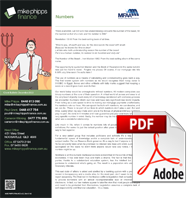"Here is wisdom. Let him who has understanding calculate the number of the beast, for the number is that of a man; and his number is 666."
Revelation 13:18 From the best-selling book of all time.
"Woe to you, oh earth and sea, for the devil sends the beast with wrath
Because he knows the time is short
Let him who hath understanding reckon the number of the beast
For it is a human number, its number is six hundred and sixty-six"
The Number of the Beast -, Iron Maiden 1982. From the best-selling album of the same name.
The opportunity to quote Iron Maiden and the Book of Revelation in the same bulletin was just too hard to resist. Forgive me please. Of course, if our mortgage rate hits 6.66% any time soon I'm outta here !
The use of numbers as a means of calculating and communicating goes back a way. The first known system with numbers as we would recognise them today dates to 3100BC in Egypt. Bones and other artifacts with tally marks suggest that keeping a score or a record goes back even further.
Our world today would be unimaginable without numbers. All modern computers use binary numbers at the core of their operation. A virtual world of zeroes and ones is at the very heart of pretty much every bit of technology we interact with and every process we encounter. Numbers inform our lives and have very significant real world impacts. From telling us a safe speed to drive to making our mortgage payments unaffordable; the numbers rule our lives. We can speak the truth with numbers, we can deceive, and we can lie. There is no part of our lives in which numbers don't play a part. But wait Mike, surely when my soul mate and I are in the throws of physical intimacy numbers play no part. Be done in 5 minutes and I can guarantee you your soul mate will have a very specific number in mind. Sadly, the number may be the beginning of the end for what was a wonderful relationship.
Like much in life, when it comes to numbers lots of people like fancy terms and definitions. For some it's just the default position after years in academia, for others a way to feel superior.
For a very select group that includes politicians and activists it's a way to hide fundamental lapses of knowledge and/or a complete lack of understanding of the subject matter. For our Reserve Bank governor, it's a way to test if anyone is listening. Turns out plenty were when he promised no interest rate rises until 2024. Luckily, he's apologized on the basis he didn't think anyone would take any notice. I think his number might be up.
Nowhere is all this numeric malfeasance more evident than in the worlds of finance and economics. It has ever been thus and that's a shame. The fact is that the average punter, thanks to a substandard education system, has the intellect but not the guidance to understand what's going on. The result is a population who are largely financially illiterate.
This sad state of affairs is aided and abetted by a banking system with a pretty poor record in transparency and a media who, for the most part, don't seem to be able to report accurately. The final nail in the finance coffin is legislation that compels lenders to provide borrowers with an almost incomprehensible level of information and disclosure. In fact, our law makers appear to take the view that most people are stupid and need to be protected from themselves. Legislation assumes a complete lack of self-responsibility and financial education. It's a mess.
So, in a one-man crusade to help here's a few thoughts on how best to see finance and economics through the prism of numeric simplicity. It works for me albeit I'm a pretty simple bloke.

Money
If ever there was a numerically based device less well understood I'm yet to find it. All that we do to plan our economic lives and measure the outcome stems from currency-based values. Here's the thing though. Money, of itself, is worthless and as such needs to be seen for what it really is. That's a way of valuing and exchanging things of value such as labour, goods and services and assets. You could have a million bucks in the bank but if you can't use that money to trade for food, shelter and sports cars what's the point? Start thinking of money as a numeric measure and you're on the right road.
Interest Rates
Rates go up and rates go down. By the time it's clear they are on the way up the fixed rate horse has probably bolted. If having rate certainty helps you sleep fix before the variable rate starts to move. It's a punt because you will pay a higher fixed rate in most cases, and you will only be ahead of the game once variable rates rise past your fixed rate. If variable rates don't rise your punt is a loser. Even if variable rates eventually exceed your fixed rate you are only ahead for the balance term of your fixed rate. Until then you are behind the eight ball and may never get your fixed rate interest premium back.
If you are using interest only debt to invest, be sure the return on that asset exceeds your interest costs. Remember, the return will comprise both day to day cash flow and capital growth. If your cash flow doesn't cover your costs and there's limited capital appreciation you are on a loser. It's called negative gearing for a reason.
Here's a simple but useful little formula :
Debt x interest rate less income = negative number. Add expected annual asset appreciation = positive number = happy days. Add tax write offs and happier days. Sell at huge profit, take cost base adjusted capital gain, pay some capital gains tax = investment nirvana.
Shares
Like interest rates, shares go up and down. Rising interest rates tend to place pressure on share prices as the rates give improved returns on cash. If you are happy with your share portfolio don't panic and sell at the bottom. People say they have lost money on shares they haven't sold. That's a paper loss, not a real one. If you don't need the dough, don't crystallise the loss. Unlike house prices you can see the value of your shares down to the last cent every day. This can create a sense of panic which tends to drive a sell low, buy high mentality in many investors. Resist the temptation to look at them every day.

Return on Investment (RoI)
This is where the dreaded percentage calculation rears its ugly head. Percentages can be useful, particularly when comparing investment opportunities or tracking trends. Of course, percentages can also be used to quote Mark Twain, to tell lies, damn lies and statistics.
Anyway, this is a simple calculation of gross return. Take the profit from the investment, divide by the price and multiple by 100. You end up with a number which you can compare with other investment opportunities. Importantly, you also end up with a number you can use to decide if the investment risk is reflected in the return.
Return on Equity (RoE)
Often confused with RoI but usually a very different beast. Most investors borrow after putting in some of their own coin. RoE is the calculation to determine what return that equity will achieve. Here we need to know the adjusted net profit after interest costs, from there it's the same calculation as RoI. Adjusted profit divided by equity x 100. If you are in a syndicate, simply use your individual equity and your share of the adjusted net.
Leverage
Ah, the miracle of leverage. Put simply, leverage is an investment strategy of using debt to increase potential investment returns. Put even more simply, the more 5% debt you can get to put into a 14% RoI asset the better. And yet, not. Just as leverage can multiply upside opportunities it can also greatly increase downside risk. I think over leveraged and highly leveraged were two terms most used during the GFC. The trick is to find a balance point where leveraged return and gearing risk can be managed at acceptable levels. This is particularly true in an environment where interest rates have been at historic lows and are rising fast. If you want a benchmark to risk assess RoI, RoE and leverage strategies you could do worse than looking at bank deposit rates and returns on blue chip shares.
Net Present Value of Future Cash Flow
At the risk of lapsing into the esoteric this one is important. If you are in the business of buying assets with term contracts attached (motel leases, management rights) then you are in the future cash flow game. Let's say you pay a landlord for a few more years on a motel lease or spend some dough lobbying a body corporate for a 5 year top up. Unless you are selling, in which case more years will improve your price, you have basically invested in a future cash flow. You've paid today's money in order to derive a cashflow many years distant. That future cash flow has a today's money value and it's important to appreciate the dynamic at play here.
Sadly, I'm not bright enough to explain the formula here and there are way too many variables to make the explanation simple. Talk to your accountant.

Opportunity Cost of Employed Capital
Another pretty simple concept that's largely overlooked in the numbers game. In essence your choices on how you use your capital come at a cost. A good example is a do-nothing investment strategy. Let's say your super fund is poorly run and returns are modest while other, more appealing super funds are available. The opportunity cost of doing nothing becomes the difference between the two funds.
I think every investment decision should be informed by a "what else could I do with the money" analysis which compares opportunities in the context of risk and return. Of course, if the investment is jewellery for the managing director, then the opportunity cost calculation looks more like this:
Mike says no = opportunity to live elsewhere – desire to retain current assets = visit to jeweller.
I'll leave you with Albert Einstein, a bloke who I suspect could do a way better job of explaining numbers.
"Compound interest is the eighth wonder of the world. He who understands it, earns it … he who doesn't … pays it."
Ok, now I feel superior. Feels good !
Mike Phipps F Fin
Director | Phippsfin Pty Ltd







